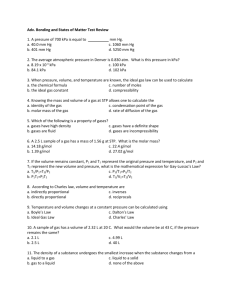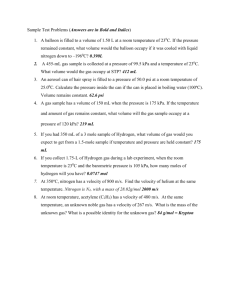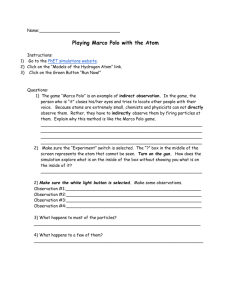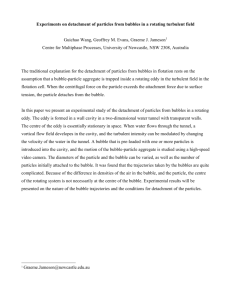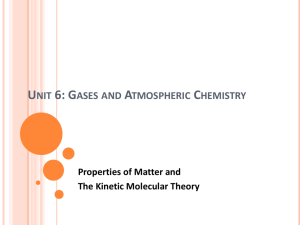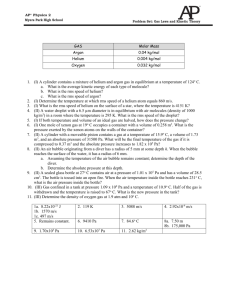Name: #1 Diana in Rome Diana, a physics student at COD, is
advertisement
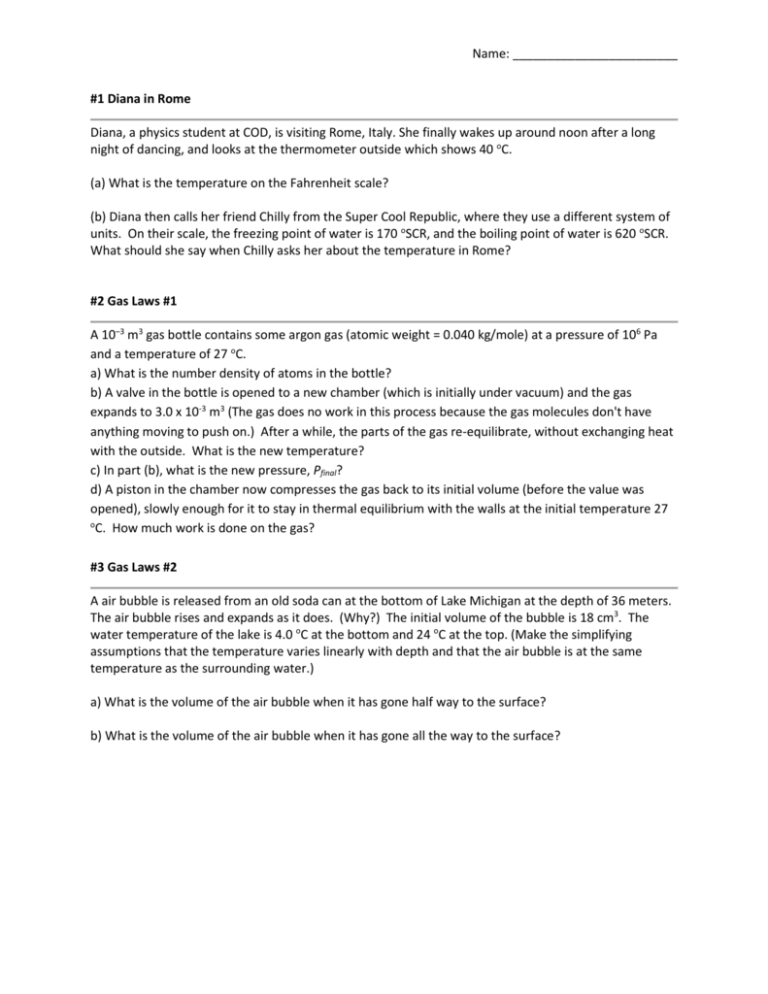
Name: ________________________ #1 Diana in Rome Diana, a physics student at COD, is visiting Rome, Italy. She finally wakes up around noon after a long night of dancing, and looks at the thermometer outside which shows 40 oC. (a) What is the temperature on the Fahrenheit scale? (b) Diana then calls her friend Chilly from the Super Cool Republic, where they use a different system of units. On their scale, the freezing point of water is 170 oSCR, and the boiling point of water is 620 oSCR. What should she say when Chilly asks her about the temperature in Rome? #2 Gas Laws #1 A 10–3 m3 gas bottle contains some argon gas (atomic weight = 0.040 kg/mole) at a pressure of 106 Pa and a temperature of 27 oC. a) What is the number density of atoms in the bottle? b) A valve in the bottle is opened to a new chamber (which is initially under vacuum) and the gas expands to 3.0 x 10-3 m3 (The gas does no work in this process because the gas molecules don't have anything moving to push on.) After a while, the parts of the gas re-equilibrate, without exchanging heat with the outside. What is the new temperature? c) In part (b), what is the new pressure, Pfinal? d) A piston in the chamber now compresses the gas back to its initial volume (before the value was opened), slowly enough for it to stay in thermal equilibrium with the walls at the initial temperature 27 o C. How much work is done on the gas? #3 Gas Laws #2 A air bubble is released from an old soda can at the bottom of Lake Michigan at the depth of 36 meters. The air bubble rises and expands as it does. (Why?) The initial volume of the bubble is 18 cm3. The water temperature of the lake is 4.0 oC at the bottom and 24 oC at the top. (Make the simplifying assumptions that the temperature varies linearly with depth and that the air bubble is at the same temperature as the surrounding water.) a) What is the volume of the air bubble when it has gone half way to the surface? b) What is the volume of the air bubble when it has gone all the way to the surface? #4 Van der Waals Gas (a) Calculate the volume of by 4.0 mol of water vapor at 250 oC that is under a pressure of 7.5 x 105 Pa. The ideal gas law, PV = nRT is derived under the assumption that the particles in the gas are point particles and collide with perfectly elastic collisions. These assumptions are reasonable when dealing with gases at sufficiently low densities. However, if the gas is sufficiently dense, modifications to the ideal gas behavior need to be made. First, examination of the ideal gas law reveals that the volume of a gas extrapolates down to zero in the limit of zero absolute temperature. Since the gas particles themselves do take up a finite volume, the true available volume through which the molecules can move is a bit smaller than the volume of the enclosure. Let b represent of unavailable volume per mole of gas. Then the ideal gas law is modified to: 𝑃(𝑉 − 𝑛𝑏) = 𝑛𝑅𝑇 Second, the gas particles experience weak attractive forces in the proximity of other gas particles due to electrical effects. These forces tend to reduce the kinetic energy of receding gas particles since they have to do work against these attractive forces to move away from each other. This tends to reduce the pressure of the gas within the enclosure. This reduction in pressure can be well modeled as being proportional to the square of the molar density (n/V) of the gas. The equation of state is now modified to: 𝑛 2 (𝑃 + 𝑎 (𝑉) ) (𝑉 − 𝑛𝑏) = 𝑛𝑅𝑇 , where a, (like b), is a constant that depends on the type of gas enclosed. This modification to the ideal gas law is called the Van der Waals gas law. (b) Consider again our water vapor, where the Van der Waals constants are a = 0.547 Pa m3 and b = 3.05 x 10–5 m3/mol. Calculate the pressure exert by 4.0 mol of water vapor at a temperature of 250 oC if it occupies a volume equal to the correct answer found in Part (a). (c) If we model a water molecule to be a sphere, calculate the radius of a water molecule. #5 Molecular Speed A box contains 100 gas atoms, 60 of helium and 40 of argon in thermal equilibrium. The atomic weight (i.e. the mass per mole) of He is 0.004 kg/mol, and of Ar is 0.040 kg/mol. The total kinetic energy of the collection of 100 atoms is 22 x 10–20 J. (a) What is the mass of each He atom? (b) What is the average kinetic energy of each He atom? (c) What is the average kinetic energy of each Ar atom? (d) What is the average square of the speed of each He atom? (e) What is the average square of the speed of each Ar atom? (f) What is the temperature of this gas? #6 Ideal Gas Work A quantity of ideal gas at 40 oC and 140 kPa in a sealed balloon occupies a volume of 0.7 Liters (L). (a) How many moles of gas are present? (b) If the temperature is raised to 60 oC and the pressure is raised to 340 kPa, what volume does the gas now occupy (assuming no leaks)? (c) The gas now has its pressure lowered from 340 kPa to 140 kPa isothermally at temperature 60 oC. Calculate the final volume of the gas. (d) Calculate the work done by the gas during the isothermal process described in part (c). (e) The gas is now compressed from the volume found in part (c) back to its original volume of 0.7 L at a constant pressure of 140 kPa. Calculate the work is done by the gas during this isobaric process?

